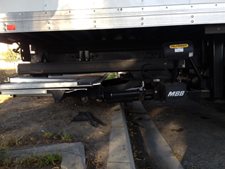 |
| Tucked away lift gate |
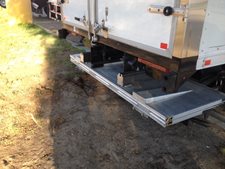 |
| Lift gate being slid out from under truck |
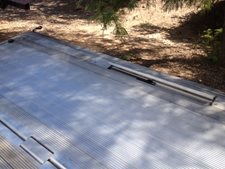 |
| Safety flaps raised to stop anything from rolling off the gate |
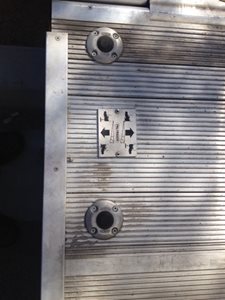 |
| Feet Controls for up and down movement of gate |
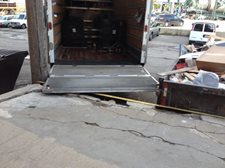 |
| Lift gate is use |
Within the transportation industry there are many different operations that require specialized equipment. One of those pieces we have is a lift gate, designed to aid in the loading and unloading of freight from the truck without a dock.
Lift gate defined on Wiktionary, Lift gate "A closure at the rear of a vehicle that can be mechanically raised during loading or unloading of heavy cargo". Most definitions of lift gates were referring to automotive hatches on the rear of a vehicle, not something we would use on a truck or trailer and probably not handling the kind of weight we need to handle.
Most lift gates we see on trucks and trailers are electro/hydraulic, meaning there is an electric motor turning a hydraulic pump that moves fluid within cylinders to make the gate function. Switches pressed or moved by the operator control almost all functions of the gate. Some lift gates have a self-leveling feature that is a great feature to have if you move freight on unleveled ground.
There are many styles or models of lift gates available for use on trailers that fit a variety of operations and trailer types. The Slider is a gate that folds up and slides under the trailer for storage, this is the type we have on our straight truck. We chose this type of gate for a couple of reasons. We back into docks the same as a trailer would, folk trucks then drive in and out of the cargo box moving freight as needed. With the slider there is no need to remove two or three feet of the trucks frame to fit the gate. This maintains the strength needed at the rear of the cargo box to handle the fork trucks movements.
The Folding gate is probably most common on straight trucks, easy to use and economical. I would not use one on a straight truck that will have a lot of fork truck traffic. The folding gate can also be ordered with an auto fold option, it will fold itself with the press of a button.
The Cantilever gate is designed to be used as a lift gate, a rear door and an adjustable dock plate. If you use a lot of different docks and fork trucks I don't think this one is for you. If your business moves a lot of household or office furniture or does a lot of home type deliveries of large items this is perfect. Very easy to use large platform, the lift gate, when stowed is like a security device for the cargo space, it covers most of the door opening and will prevent anyone from accessing the door hardware.
The Column type can be installed on most trailers or box trucks but will add length to the unit it is being installed upon. Simple to install and operate. The column type will not work at a dock that has a dock lock, unless you can use it as a dock plate. Ground loading only with this one. When stowed it covers half the door but will lower enough to use a dock plate if needed.
The Sideloader is just that, a gate that attaches to the side of the trailer to allow loading and unloading of freight from the side of the trailer. Only special delivery needs would need one of these. We have seen this type at restaurants making deliveries in the limited space they are allowed at the rear of the building.
Believe it or not there are safety features that are available on some lift gates. Foot controls, there are two "buttons" on the platform of the gate, that when stepped on in the right order the gate will move up or down as directed by the operator. This feature allows the operator to hang on to the freight to give more stability to tall items, while still running the gate. Cart stops, these are "flaps" that fold up out of the surface of the platform to prevent something from rolling off the end of the platform; they stow away to allow easy exit from the gate platform.
The thing about lift gates is that they need to be thick enough, which could be up to three inches, to handle weight, but you still need to get the freight on or off the gate when on the ground. If the gate is level with the truck when it hits the ground, the end of gate could be three inches off the ground. This is where the Auto level comes in, once the gate hits the ground the auto level will lower or tilt the gate towards the ground, giving the operator minimal lip to drive the pallet jack over when loading or unloading. The reverse is true when raising the gate, you get the freight on, step on the right buttons and the gate will level itself before lifting. A fantastic feature.
Warning lights, these are lights mounted to the surface of the platform facing traffic. A feature that is good when moving freight in the street. I still use traffic cones but these lights are just a little extra that may prevent an accident, they move with the platform so they could be at ground level, four feet or anywhere in between.
When making a lift gate purchase research your options, we bought a gate that could move to another truck without destroying the old trucks value. Lift gates are not one of those investments you buy the cheapest you can find. Think about your future and the future of the piece of equipment you will install the gate on. If you plan on running for years, with several pieces of equipment that you may be able to move the gate to buy the best you can get. If you are on your last piece of equipment and you need to get you through to retirement, maybe a less expensive but still safe gate will work. Watch the weight capacities of the gate you intend to purchase, it will need to do what you need done.
We have a Palfinger ILUK gate and I believe it is one of the best available for our type of work, check it out at www.interlift.net . Other sources would be at www.thieman.com/tailgate/, www.maxonlift.com/products, www.anthonyliftgates.com/, www.waltcoliftgates.com/, these are a few manufacturers but we have only owned a Palfinger/Interlift, german technology is known for innovations.